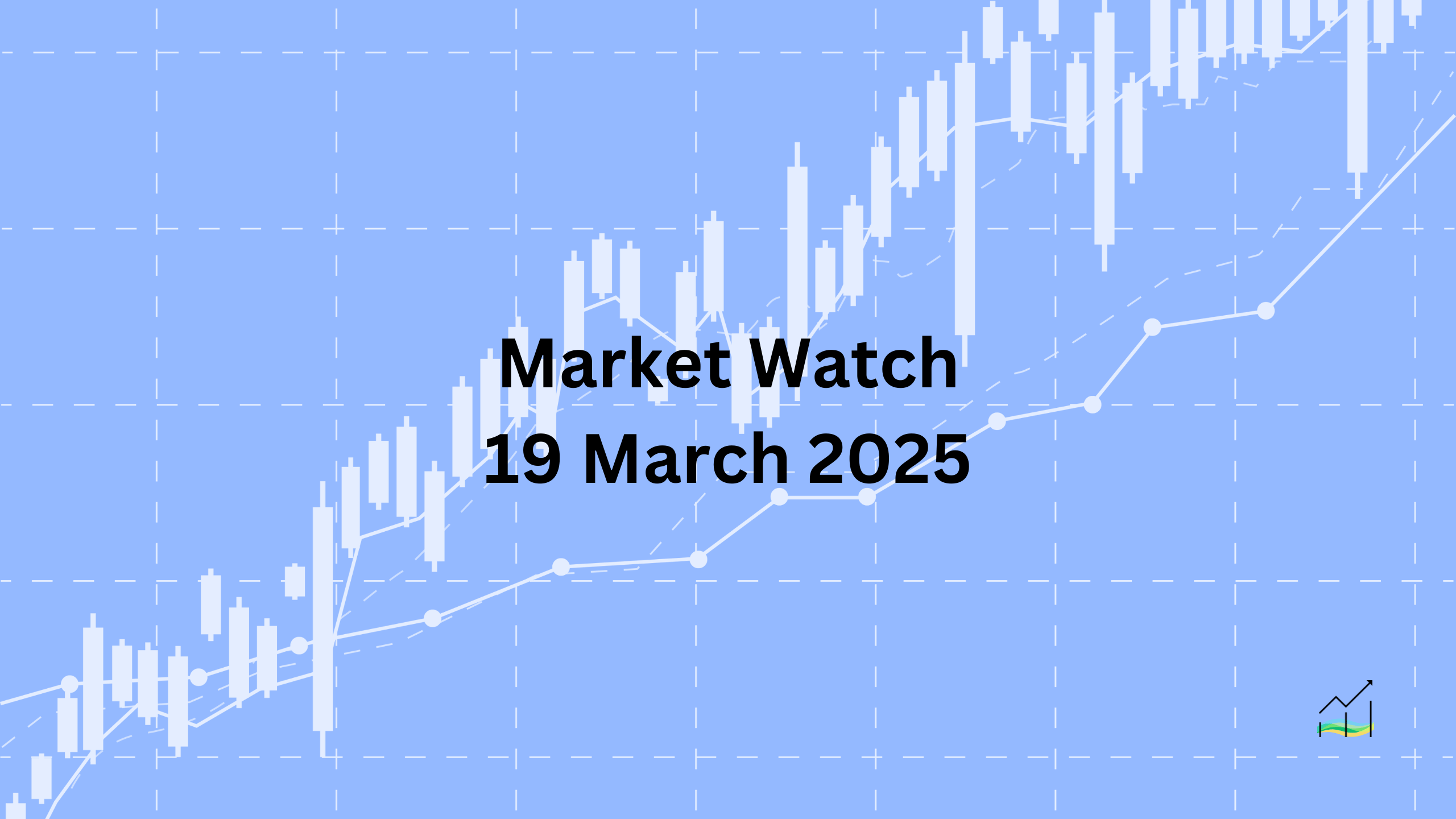19/03/2025 Market Watch

Fed's Forward Guidance & Market Adjustments
The Federal Reserve’s messaging holds significant influence in today’s market, with investors closely watching its updated forecasts and Chair Powell’s remarks. While the Fed is expected to keep interest rates unchanged, the Summary of Economic Projections will be a crucial indicator of future policy direction. Powell is likely to emphasize a patient approach, waiting for clearer signals on the economic impact of current policies before making any moves. Ahead of the FOMC decision, market movements are driven by position adjustments, leading to a short-term rebound in the U.S. dollar. The greenback is strengthening against G10 and most emerging market currencies, with recent selling pressure from Europe showing signs of easing.
Equity markets are displaying mixed trends. In the Asia-Pacific region, performance is varied, while Europe's Stoxx 600 has declined slightly after four consecutive sessions of gains. U.S. stock futures suggest a modestly firmer open. Bond markets remain steady, with European benchmark 10-year yields softening by 2-3 basis points, while the U.S. 10-year Treasury yield is holding at 4.28%.
Gold prices reached a new record high near $3,045 before experiencing profit-taking, pulling it back to around $3,022. However, renewed buying interest in Europe has lifted prices back above $3,030. Meanwhile, crude oil prices have weakened. After peaking at $68.50, the highest level since early March, WTI crude reversed direction, dropping below $66 as selling pressure continued.
United States of America
Overview
The U.S. dollar experienced volatile movements, initially testing upside levels before pulling back. The Dollar Index reached a session high above 103.65 before declining to a marginal new low near 103.20. It recovered to around 103.70 in Asia but lost momentum in Europe, where recent dollar selling has been prominent. The Federal Reserve meeting is the key focus today, with markets paying more attention to its statements than its actions. While no policy changes are expected, updates in the Summary of Economic Projections could provide valuable insights into the Fed’s stance.
Economic Drivers
The Federal Reserve's outlook is shaped by economic growth forecasts and inflation expectations:
- The December median Fed forecast projected 2.1% GDP growth for 2025, lower than the 2.8% in 2024.
- The Personal Consumption Expenditures (PCE) inflation is expected to settle at 2.5% for both headline and core measures, down from previous estimates of 2.5% and 2.8%, respectively.
- Market sentiment leans toward slightly slower growth and higher inflation due to government policies.
- The median dot plot from the last meeting suggested two rate cuts in 2025, but this remains uncertain.
- Speculation that the Fed might halt its balance sheet reduction has diminished after the resolution of the debt ceiling issue.
Data and Events
The following scheduled announcements will provide further clarity on policy direction:
- Federal Reserve Meeting Outcome – No rate change expected, but focus is on economic projections and Powell’s commentary.
- Summary of Economic Projections (SEP) – Insights into Fed officials' expectations for GDP, inflation, and interest rate adjustments.
- Fed Chair Powell’s Speech – Potentially reinforces a cautious stance amid policy uncertainty.
Price Action
The U.S. dollar remains under pressure, with sellers emerging in Europe. The Dollar Index attempted an upside move but faced resistance near 103.65 and fell to a new low of 103.20. A partial recovery in Asian trading was met with selling in European hours, keeping the currency range-bound. Markets await further direction from the Fed’s statements.
Key Points:
- The Fed is expected to hold rates steady but may adjust economic projections.
- GDP growth forecasts suggest a slowdown, with inflation remaining firm.
- The market anticipates two rate cuts this year, but it's uncertain.
- Speculation on balance sheet reduction pausing has faded.
- The U.S. dollar faced resistance at 103.65 and remains under pressure in Europe.
Australia
Overview
The Australian dollar struggled to hold gains near $0.6400, facing strong resistance before being pushed back to $0.6345. Losses extended further today, with the currency testing Monday’s low near $0.6320. The inability to sustain upward momentum may discourage new buyers, and a break below $0.6300 could trigger further selling. The focus now shifts to Australia’s February employment report, which could influence market sentiment.
Economic Drivers
Labor market conditions are key to the Australian dollar’s outlook:
- Employment growth has averaged 37.1k jobs per month in 2024, compared to 31.1k per month in 2023.
- Full-time job creation remains strong, averaging 25k per month in 2024, up from 8.6k per month in 2023.
- Despite job gains, the participation rate has risen, pushing the unemployment rate to 4.1%, near the upper end of its two-year range.
Data and Events
Australia’s employment data, due tomorrow, will be closely monitored:
- February Employment Change – A key indicator of labor market strength.
- Unemployment Rate – Expected to remain elevated due to rising labor force participation.
Price Action
The Australian dollar faced resistance near $0.6400 and was forced lower. A decline below $0.6320 has increased downside risks, with $0.6300 acting as a key support level. A failure to hold this level could lead to further selling pressure.
Key Points:
- The Australian dollar failed to hold above $0.6400 and fell to $0.6320.
- Strong employment growth has not been enough to offset the rising participation rate.
- The unemployment rate remains at the upper end of its two-year range.
- February employment data will be crucial in shaping market expectations.
- A break below $0.6300 may lead to further selling pressure.
Canada
Overview
The US dollar briefly hit an eight-day low near CAD1.4270 following stronger-than-expected Canadian inflation data before rebounding to CAD1.4320 in North American trading. Despite signs of weakness, with the five-day moving average slipping below the 20-day average, the dollar remains well-supported, reaching CAD1.4330 today. Resistance is seen around CAD1.4340-50. Investors are now focusing on upcoming Canadian retail sales data and political developments.
Economic Drivers
The Canadian economy is facing shifting inflation and policy expectations:
- Inflation surged by 1.1%, nearly double forecasts, marking the largest monthly increase since 1997.
- Core inflation also rose to 2.9% from 2.7%, reinforcing price pressures.
- Rate cut expectations have adjusted, with the probability of an April cut falling to 30%, down from 50% earlier this month.
- Consumer sentiment may be affected by anecdotal reports of a US goods boycott in Canada.
Data and Events
Key reports and political events could influence the market:
- Canadian Retail Sales (January) – Expected to show slower growth after December’s 2.5% surge.
- Potential Snap Election Call – Prime Minister Carney may announce an early election before March 24.
Price Action
The US dollar remains volatile against the Canadian dollar. It briefly dipped to CAD1.4270 before rebounding to CAD1.4320 and later testing CAD1.4330. The five-day moving average slipping below the 20-day average suggests a weaker trend, but nearby resistance at CAD1.4340-50 remains in focus.
Key Points:
- The US dollar hit an eight-day low before rebounding against the Canadian dollar.
- Canadian inflation surged, reducing the likelihood of an April rate cut.
- Consumer sentiment may be affected by reports of a US goods boycott.
- Retail sales data and potential election developments are key market drivers.
- Technical resistance is seen at CAD1.4340-50, while a break below CAD1.4270 could signal further downside.
China
Overview
The US dollar remains near its lowest level since the US election, with last week’s low at CNH7.2155. It has firmed slightly today, reaching CNH7.2415, while Monday’s high was closer to CNH7.2450. Notably, the CNH7.22 level aligns with the 38.2% retracement of the dollar’s rise from last September’s low. The People’s Bank of China (PBOC) set today’s reference rate at CNY7.1697, slightly lower than yesterday’s CNY7.1733. While adjustments to the fix have been minor, any shifts remain crucial for monitoring China’s exchange rate strategy.
Economic Drivers
China’s monetary policy remains steady, with a focus on fiscal support:
- The PBOC’s reference rate continues to see only slight adjustments, signaling stability.
- The yuan is trading firm, reducing immediate pressure for monetary easing.
- The PBOC prefers fiscal measures over monetary easing to counter external risks.
- Policy flexibility is being preserved in case further actions are needed against US tariffs.
Data and Events
China’s scheduled interest rate decision is the key event to watch:
- Loan Prime Rate Decision (Tomorrow) – Expected to remain unchanged at 3.10% (1-year) and 3.60% (5-year).
Price Action
The US dollar remains in a tight range, recovering from last week’s low of CNH7.2155 and reaching CNH7.2415 today. Resistance is around CNH7.2450, while support is at CNH7.22, which aligns with key retracement levels. A stronger move above CNH7.2450 or a drop below CNH7.22 could dictate the next direction.
Key Points:
- The US dollar remains near its lowest level since the US election.
- The PBOC’s reference rate adjustments have been minor but are being closely watched.
- China’s central bank is not rushing to ease monetary policy despite a firm yuan.
- Loan prime rates are expected to remain steady in tomorrow’s decision.
- Resistance is seen at CNH7.2450, while key support is near CNH7.22.
Europe
Overview
The euro tested key levels after strong US housing data, initially dropping below $1.09 before rebounding toward $1.0955. Today, the currency dipped to $1.0875 but resurfaced above $1.09 in early European trading. Meanwhile, the US-German two-year yield spread has widened by 22 basis points since its five-month low, which could support the dollar. The focus now shifts to upcoming events, including the Bundesrat’s fiscal vote and next week’s PMI data.
Economic Drivers
The euro’s movement is influenced by strong US economic data and widening yield spreads:
- US housing starts surged by 11.2% in February, far exceeding the 1.4% forecast, boosting the dollar.
- The US-German two-year yield spread has rebounded by 22 basis points, lending support to the dollar.
- Germany’s new fiscal initiative passed in the Bundestag, with a final Bundesrat vote expected tomorrow.
Data and Events
Market participants are watching the following key events:
- Bundesrat Vote (Tomorrow) – Expected approval of Germany’s fiscal initiative.
- Preliminary PMI Data (Monday) – Provides insight into economic activity in the eurozone.
Price Action
The euro remains in a volatile range, testing key support and resistance levels. After falling to $1.0875, it recovered above $1.09 in early European trading. The broader trend may depend on whether the euro continues to find buyers on dips or if the widening yield spread starts weighing it down further.
Key Points:
- The euro dipped below $1.09 but recovered toward $1.0955 before pulling back.
- US housing data came in much stronger than expected, boosting the dollar.
- The US-German two-year yield spread widened, favoring the dollar.
- Germany’s Bundesrat vote on fiscal measures is expected tomorrow.
- Preliminary PMI data next Monday will offer further economic insights.
Japan
Overview
As expected, the Bank of Japan (BOJ) left policy unchanged, with Governor Ueda raising concerns about potential US trade tariffs. The next BOJ meeting on May 1 provides time to assess US trade actions, particularly reciprocal and sector-specific tariffs. Estimates suggest that US auto tariffs could impact 0.75% of Japan’s GDP, rising to 1% if auto parts are included. Meanwhile, the Japanese economy showed signs of a weak start to the year, with core machine tool orders declining by 3.5% in January, far worse than the 0.1% expected.
Economic Drivers
Japan’s economic outlook is influenced by trade risks and weak domestic data:
- BOJ kept policy unchanged, with concerns about US tariffs on Japanese autos.
- US auto tariffs could impact 0.75% of GDP, rising to 1% if auto parts are affected.
- Core machine tool orders fell 3.5% in January, indicating weak industrial activity.
Data and Events
Key reports shaping the market outlook include:
- BOJ Policy Decision (Next Meeting: May 1) – Officials will reassess economic risks.
- Japan Trade Balance (February) – The JPY584.5 billion surplus follows a JPY415 billion deficit in February 2024 and a JPY941 billion deficit in 2023.
- US Trade Policy Developments – Market focus remains on potential reciprocal and sector tariffs affecting Japan.
Price Action
The US dollar tested JPY150, briefly surpassing the level before being pushed down to JPY149.15. Strong bids in European trading lifted it back toward JPY149.70. The market remains sensitive to shifts in US-Japan trade dynamics and upcoming BOJ policy moves.
Key Points:
- The BOJ left policy unchanged, citing concerns over US trade policies.
- US auto tariffs could impact Japan’s GDP by 0.75%-1%.
- January’s core machine tool orders dropped 3.5%, signaling a weak start to the year.
- Japan’s trade balance improved, with exports rising 11.4% YoY in February.
- The dollar briefly surpassed JPY150 before retreating, with strong bids emerging at lower levels.
United Kingdom
Overview
Sterling briefly surpassed $1.30 before facing resistance in North American trading, dropping to $1.2950 before rebounding. The currency remains within a $1.2960-$1.3005 range today, with broader resistance extending toward $1.3050. The market focus now shifts to UK employment data and the Bank of England (BoE) meeting, where no immediate policy change is expected. However, traders are increasingly pricing in a rate cut by mid-year.
Economic Drivers
The UK economy is showing signs of a gradual slowdown, but not enough to force an immediate rate cut:
- The labor market is cooling, but not sharply enough to warrant an urgent policy shift.
- Markets assign nearly a 75% chance of a rate cut in May, though expectations remain uncertain.
- A rate cut is fully priced in by August, signaling expectations of a looser monetary stance in the coming months.
Data and Events
Key economic updates that could influence sterling’s outlook:
- UK Employment Data (Tomorrow) – A key indicator for labor market trends.
- Bank of England Meeting (Tomorrow) – No rate cut expected, but future guidance will be closely analyzed.
Price Action
Sterling remains range-bound, trading between $1.2960-$1.3005, with a broader resistance band extending toward $1.3050. The week’s low was just below $1.2920. The currency’s ability to hold above $1.2950 suggests continued buyer interest, while further gains may be capped by resistance levels.
Key Points:
- Sterling briefly moved above $1.30 before pulling back.
- The UK labor market is cooling but not enough to force an immediate rate cut.
- Markets see a 75% chance of a rate cut in May, with full pricing by August.
- The UK employment report and BoE meeting tomorrow will be key drivers.
- Sterling is holding within a $1.2960-$1.3005 range, with resistance at $1.3050.
© 2025 SKONE Enterprise (003319453-V). All rights reserved.
The content on this site is for informational purposes only and does not constitute financial advice.


